Exploring Pakistan

Situated on the crossroads of South Asia, the Middle East and Central Asia, Pakistan is a beautiful country with a unique history and cultural heritage. Pakistan was the site for one of the world's earliest human settlements: the great prehistoric Indus Valley Civilization, the crucible of ancient empires, religions and cultures. The land of Pakistan ranges from lofty mountains in the north, the Karakoram and the Himalayas, through dissected plateaus to the rich alluvial plains of the Punjab. Then follows the desolate barrenness of Baluchistan and the hot, dry deserts of Sindh blending into miles and miles of golden beaches of Makran coast.
Pakistan A Tourist Paradise


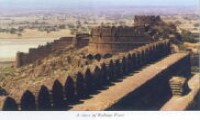
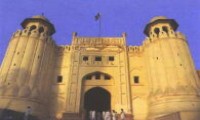










Pakistan main attractions include adventure tourism in the Northern Areas, cultural and archaeological tourism as found in Taxila, Moenjodaro, Harrappa, and early Muslim and Mughal heritage at Multan, Lahore, Thatta, Peshawar and Swat.
Provinces of Pakistan
Pakistan has four Provinces and they are :
- Punjab
- Sindh
- Khyber Pakhtunkha
- Balochistan
Islamabad the capital of Pakistan is a Federal Capital Area
Punjab
Punjab, its name meaning 'Land of Five Rivers', is the richest, most fertile and most heavily populated province of Pakistan. (The five rivers referred to the Jhelum, Chenab, Ravi, Sutlej and Beas)
The best time to visit northern Punjab is in the spring, from February to April, and in the autumn, from September to November. Southern Punjab is extremely hot in summer, so Multan is at its best in winter, from November to February.
Lahore


Situated on the east bank of the Ravi River, Lahore is a very old city. Legend traces its origin to Loh, the son of Rama Chandra, the hero of the Ramayana, but history records that it began as a dependency of the 8th century AD Hindu ruler, Lalitiditya. In the early 11th century it came under Muslim rule and evolved as a centre of Islamic culture and learning as well as trade and commerce. In the 13th century it was depopulated and razed to the ground by the Tartar-Mongol hordes of Genghis Khan. Lahore was a cultural and intellectual centre during both the Mughal and British eras, but it is the diversity and contrast of the different sections of the city which make Lahore interesting.
Badshahi Mosque
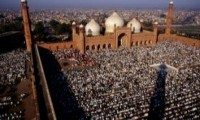 The Imperial or the Badshahi Mosque is across the courtyard from Alamgiri Gate of the Lahore Fort. The Mosque, which is made up entirely of red sand-stone, was built by Emperor Aurangzeb, the last of the great Mughals, in a record time of two and-a-half years.
The Imperial or the Badshahi Mosque is across the courtyard from Alamgiri Gate of the Lahore Fort. The Mosque, which is made up entirely of red sand-stone, was built by Emperor Aurangzeb, the last of the great Mughals, in a record time of two and-a-half years.
Minar-e-Pakistan
 Minar-e-Pakistan is a new landmark in Lahore and stands in the Iqbal Park to commemorate the date when a resolution was passed there in 1940 demanding the creation of separate homeland for the Muslims of South Asian sub-continent. The Minar is a blend of Mughal and modern architecture. The Minar is about 60 meters tall.
Minar-e-Pakistan is a new landmark in Lahore and stands in the Iqbal Park to commemorate the date when a resolution was passed there in 1940 demanding the creation of separate homeland for the Muslims of South Asian sub-continent. The Minar is a blend of Mughal and modern architecture. The Minar is about 60 meters tall.
Shalimar Gardens
 Three miles east of Lahore are the famous Shalimar Gardens laid out by the Mughal Emperor Shah Jehan in 1642 AD. The Gardens are spread out in typical Mughal style and are surrounded by high walls with watch-towers at the four corners. Originally, the gardens were spread over seven ascending terraces, but only three remain now which cover an area of about 42 acres. The brick-work of the floors of the three terraces have been repaired according to their original designs which differ on all three terraces. There is a marble pavilion underneath with water flows and cascades down over a carved, marble slab creating a waterfall effect. Across the waterfall is a marble throne. At the end of the second terrace is a beautiful structure called Sawan Bhadon, a sunken tank niches on its three sides. Water cascades down from it in sheets in front of the niches, producing the sound of falling rain.
Three miles east of Lahore are the famous Shalimar Gardens laid out by the Mughal Emperor Shah Jehan in 1642 AD. The Gardens are spread out in typical Mughal style and are surrounded by high walls with watch-towers at the four corners. Originally, the gardens were spread over seven ascending terraces, but only three remain now which cover an area of about 42 acres. The brick-work of the floors of the three terraces have been repaired according to their original designs which differ on all three terraces. There is a marble pavilion underneath with water flows and cascades down over a carved, marble slab creating a waterfall effect. Across the waterfall is a marble throne. At the end of the second terrace is a beautiful structure called Sawan Bhadon, a sunken tank niches on its three sides. Water cascades down from it in sheets in front of the niches, producing the sound of falling rain.
Shrine of Data Sahib

Allama Iqbal's Tomb
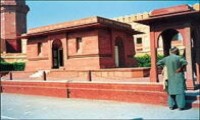
Noor Jehan's Tomb
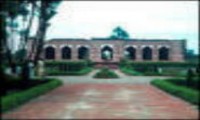
Lahore Museum
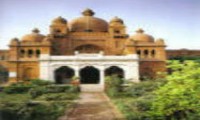
Bahawalpur

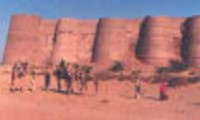
Bahawalpur is 889 km from Karachi. The founder of the state of Bahawalpur was Nawab Bahawal Khan Abbasi I. The Abbasi family ruled over the State for more than 200 years (1748 to 1954).Noor Mehal is one of the three palaces that attracts tourists. Bahawalpur is also known for its distinctly embroidered slippers and shoes and the filigree pottery. It has a marble mosque in the Fawara Chowk and a few British buildings like the Science College. Bahawalpur has a modest museum with a fine collection of coins, medals, postage stamps of former State of Bahawalpur, manuscripts, documents, inscriptions, wood carvings, camel skin paintings, historical models and stone carvings. All the pieces date back to the Islamic and the pre-Islamic period.
Uch Sharif
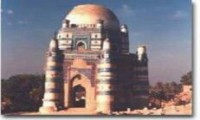
Uch Sharif, 75 km from Bahawalpur, is a very old town. It is believed that it was founded in 500 BC. Some historians believe that Uch was there even before the advent of Bikramajit when Jains and Buddhist ruled over the sub-continent. At the time of the invasion by Alexander the Great, Uch was under Hindu rule.
Uch Sharif has been described as a flourishing and beautiful town perched upon the plateau near the confluence of the Chenab and Ravi rivers. The famous shrines existing at Uch include those of Hazrat Bahawal Haleem, Hazrat Jalaluddin Surkh Bukhari, Makhdoom Jahanian Jahangasht, Shaikh Saifuddin Ghazrooni and Bibi Jawanadi. The shrine of Bibi Jawandi is a central Asian design, titled in the blue faience.
Uch is a small town today and divided into three different parts known as (i) Uch Bukhari, after Hazrat Syed Jalaluddin Bukhari Surkhposh, (ii) Uch Jilani, after the name of Hazrat Shaikh Mohammad Ghaus Qadri Jilani (Bandagi), who came from Halab in 887 AH, (iii) Uch Mughlan after the Mughal rulers
Multan
 About 966 km from Karachi, and more or less right in the centre of the country, lies the ancient city of Multan. Multan, the 'City of Pirs and Shrines,' is a prosperous city of bazaars, mosques, shrines and superbly designed tombs. It is also a city of dust, summer heat and beggars. It has a long history. Alexander the Great added it to his list of Indus conquests. In 641 AD Xuang Tzang found it 'agreeable and prosperous' - Mohammad Bin Qasim was the next to conqueror Multan in 712 AD. Mahmud of Ghazni invaded in 1006, Timurlane in 1398. In the 16th century it was the Moghuls turn, followed by the Sikhs in 1752 and the British in 1849. The old city has narrow colorful bazaars full of local handicrafts and narrow winding lanes. There are many places of historical, cultural and recreational interest in the city.
About 966 km from Karachi, and more or less right in the centre of the country, lies the ancient city of Multan. Multan, the 'City of Pirs and Shrines,' is a prosperous city of bazaars, mosques, shrines and superbly designed tombs. It is also a city of dust, summer heat and beggars. It has a long history. Alexander the Great added it to his list of Indus conquests. In 641 AD Xuang Tzang found it 'agreeable and prosperous' - Mohammad Bin Qasim was the next to conqueror Multan in 712 AD. Mahmud of Ghazni invaded in 1006, Timurlane in 1398. In the 16th century it was the Moghuls turn, followed by the Sikhs in 1752 and the British in 1849. The old city has narrow colorful bazaars full of local handicrafts and narrow winding lanes. There are many places of historical, cultural and recreational interest in the city.
Harappa

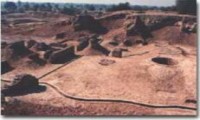
This was the first of the Indus Valley Civilization sites to be discovered, but in size and condition it is inferior to Moenjodaro. Located 186 km south-west of Lahore, Harappa is reached via Sahiwal, formerly known as Montgomery. Situated beside an earlier course of the Ravi River, Harappa was discovered in 1920-21, but through the ages the site was quarried for bricks and most of the buildings excavated so far are in poor condition.
The cemeteries discovered at Harappa confirm that the Indus Valley people buried their dead, many of them wearing finger rings, necklaces of steatite beads, anklets of paste bead, earnings and shell bangles. Copper mirrors, antimony rods, sheer spoons and vessels and urns of various shapes and size lay in the graves. Some of the female skeletons had anklets of tiny beads and girdles studded with some-precious stones. Excavations have recalled evidence of some pre-Harappa material which shows strong affinity with the Kot Diji finds.
On display at the Museum are excavated materials, including terracotta toys, gamesman, jewelry, animal figurines and bronze utensils statuettes.
Sindh
Karachi
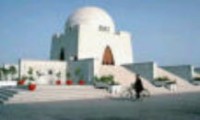
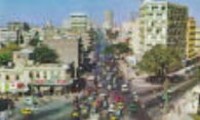
Karachi, the largest and the most populous city of Pakistan, presents an interesting and colorful combination of the old and new. The narrow twisting lanes and alleys of the old city throb with life alongside the wide roads and elegant modern buildings. Within the city, talented artisans with age-old skills produce handicrafts of exquisite beauty.
Karachi offers a variety of pleasant attractions: wide sunny beaches, deep-sea fishing, yachting, golf and horse racing all-year round. Its restaurants provide a wide choice of Pakistani and Western cuisine. Its markets and bazaar offer endless variety of exciting shopping including indigenous handicrafts, rugs and carpets of rare design and beauty.
Hyderabad
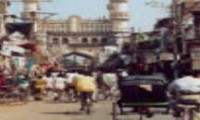 Hyderabad, 164 km north of Karachi the second largest city in Sindh and one of the largest in Pakistan
Hyderabad, 164 km north of Karachi the second largest city in Sindh and one of the largest in Pakistan
Kirthar National Park
 A four hour drive north-east from Karachi, of the Super Highway takes the visitor deep into the heart of Kirthar National Park, a space that measures over 3,000 square kilometers in the Kirthar hills and is a good destination for a three day trip. October to February is the most comfortable...that is, coolest...time to go but the flowers bloom during the (relatively) wet monsoon in August.
A four hour drive north-east from Karachi, of the Super Highway takes the visitor deep into the heart of Kirthar National Park, a space that measures over 3,000 square kilometers in the Kirthar hills and is a good destination for a three day trip. October to February is the most comfortable...that is, coolest...time to go but the flowers bloom during the (relatively) wet monsoon in August.
Moenjodaro
 At Moenjodaro (Mound of dead) in the west bank of the Indus in Sindh one can see the remains of one of the earliest and most developed urban civilizations of the ancient world. Discovered in 1922, Moenjodaro was once metropolis of great importance, forming part of the Indus Valley Civilization. Now one can find the 4,000 years old brick ruins.
At Moenjodaro (Mound of dead) in the west bank of the Indus in Sindh one can see the remains of one of the earliest and most developed urban civilizations of the ancient world. Discovered in 1922, Moenjodaro was once metropolis of great importance, forming part of the Indus Valley Civilization. Now one can find the 4,000 years old brick ruins.
The Indus Valley Civilization flourished from 3,000 to 1,500 BC, making it contemporary with the ancient civilization of Egypt and Mesopotamia. At its height it comprised at least 400 cities and towns along the Indus and its tributaries, covering most of the present-day Pakistan and stretching north-west as far as modern Kabul and east as far as modern Delhi. The water ways were the main highways connecting the empire. Flat bottomed barges almost identical to those still use today plied the rivers from city to city. Few of the cities have been excavated
Sukkur
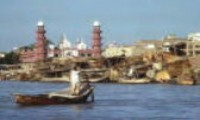 North of Larkana the landscape becomes luxuriant. In Sukkur the railway line and the highway split up, with a road and rail tracks leading north-west to Quetta via Sibi and Jacobabad, while another highway and railway line go via Rahimyar Khan and Sadiqabad straight to Multan. Sukkur is a sprawling town with beautiful mosques, gardens, and shrines. As a desert oasis town, it boasts many havelis which are decorated with geometric, floral designs and painted in a variety of bright, contrasting colors.
North of Larkana the landscape becomes luxuriant. In Sukkur the railway line and the highway split up, with a road and rail tracks leading north-west to Quetta via Sibi and Jacobabad, while another highway and railway line go via Rahimyar Khan and Sadiqabad straight to Multan. Sukkur is a sprawling town with beautiful mosques, gardens, and shrines. As a desert oasis town, it boasts many havelis which are decorated with geometric, floral designs and painted in a variety of bright, contrasting colors.
Khyber Pakhtunkha
runs for over 1,100 kilometres (680 miles) along the border with Afghanistan. Peshawar is its capital and the Vale of Peshawar, fertile and well watered by the Kabul and Swat rivers, is its heart. This was also the heart of the ancient kingdom of Gandhara and is rich in archaeological remains. The northern half of the province consists of five river valleys running roughly parallel, north to south: Chitral, Dir, Swat, Indus and Kaghan. These valleys are on the northern edge of the monsoon belt. They are fairly green and partly wooded in their southern sections.
Peshawar
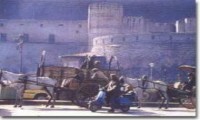 Peshawar, the capital city of North-West Frontier Province, is a frontier town, the meeting place of the sub-continent and Central Asia. It is also a place where ancient traditions jostle with those of today, where the bazaar in the old city has changed little in the past hundred years except to become the neighbor of a modern university, some modern hotels, several international banks and one of the best museums in Pakistan
Peshawar, the capital city of North-West Frontier Province, is a frontier town, the meeting place of the sub-continent and Central Asia. It is also a place where ancient traditions jostle with those of today, where the bazaar in the old city has changed little in the past hundred years except to become the neighbor of a modern university, some modern hotels, several international banks and one of the best museums in Pakistan
Excursion from Peshawar
Warsak Dam The gigantic, multi-purpose Warsak Dam is situated 30 kms north-west of Peshawar in the heart of tribal territory.
The Museum
Situated on the Grand Trunk Road in the cantonment area, the museum houses a rich treasure of art, sculpture and historical relics, particularly of the Gandhara period (300 BC - 300 AD).
Takht-e-Bhai
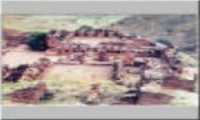 Situated atop a 160 meter high hill are the remains of a famous Buddhist monastery at Takht-e-Bhai, about 80 kms from Peshawar. This site has produced fragmentary sculptures in stone and stucco that indicate the highly developed sculptural sense of their creators. This site dates back from 2nd-3rd century AD.
Situated atop a 160 meter high hill are the remains of a famous Buddhist monastery at Takht-e-Bhai, about 80 kms from Peshawar. This site has produced fragmentary sculptures in stone and stucco that indicate the highly developed sculptural sense of their creators. This site dates back from 2nd-3rd century AD.
Khyber Pass
 The historic Khyber Pass is at a distance of 16 kms west of Peshawar and extends up to the Pak-Afghanistan border at Torkkam.
The historic Khyber Pass is at a distance of 16 kms west of Peshawar and extends up to the Pak-Afghanistan border at Torkkam.
The Swat Valley
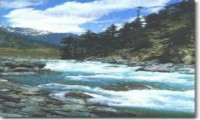 Swat is the most interesting valley in Pakistan. It is also one of the most beautiful - certainly much greener and more fertile than the valleys further north because it lies within the monsoon belt. In Lower Swat, the valley is wide, the fields on either side of the river are full of wheat and Lucerne, and the villages are prosperous and surrounded by fruit trees. In Upper Swat, the river tumbles through pine forests hemmed in by snow-capped mountains
Swat is the most interesting valley in Pakistan. It is also one of the most beautiful - certainly much greener and more fertile than the valleys further north because it lies within the monsoon belt. In Lower Swat, the valley is wide, the fields on either side of the river are full of wheat and Lucerne, and the villages are prosperous and surrounded by fruit trees. In Upper Swat, the river tumbles through pine forests hemmed in by snow-capped mountains
Lake Saif-ul-Muluk
 10 kms from Naran, this lake is 3200 meters high, providing an awe-inspiring view of Malika Parbat (Queen of the Mountains) 5,260 meters high. You can go boating on the lake and hear the local legend about Prince Saif-ul-Muluk who fell in love with fairy.
10 kms from Naran, this lake is 3200 meters high, providing an awe-inspiring view of Malika Parbat (Queen of the Mountains) 5,260 meters high. You can go boating on the lake and hear the local legend about Prince Saif-ul-Muluk who fell in love with fairy.
Fishing
The Kunhar River and the various lakes offer plenty of fishing opportunities. Both the brown and rainbow trout and the mahasheer can be found in abundance.
Balochistan
Situated west of the Indus Plains, the largest province in Pakistan with an area about 343,000 square km. Though it's bigger than the British Isles, it only has a population of about 6.5 million, due mainly to its daunting arid geography.
Baluchistan is outside the monsoon zone and has, with the exception of the hilly and arid mountainous regions, a pleasant climate. In winter the temperature falls to as low as - 30ー C while in summer it ranges from 18ー to 30ー C. The province has been influenced by the civilizations in the Indus, Dir and Swat Valleys.
Quetta
 Quetta, the capital of Baluchistan, is linked by air, rail and road with all the major cities of Pakistan, particularly Karachi, which has an international airport.
Quetta, the capital of Baluchistan, is linked by air, rail and road with all the major cities of Pakistan, particularly Karachi, which has an international airport.
Hinna Lake
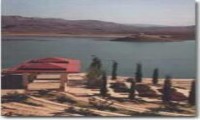 A little short of the place where the Urak valley begins and ten kms. from Quetta sits the Hinna Lake. The greenish- blue water of the lake provides a rich contrast to the sandy brown of the hills in the back ground.
A little short of the place where the Urak valley begins and ten kms. from Quetta sits the Hinna Lake. The greenish- blue water of the lake provides a rich contrast to the sandy brown of the hills in the back ground.
Ziarat
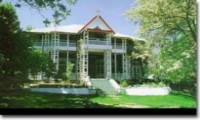 Pakistan has a number of beautiful valleys, enchanting their spectators with enthralling beauty but Ziarat is an important and an archaic treasure of Juniper forests.
Pakistan has a number of beautiful valleys, enchanting their spectators with enthralling beauty but Ziarat is an important and an archaic treasure of Juniper forests.
The summers in the valley are always pleasant, attracting a number of tourists, and the winters extremely harsh. Juniper forests, which are one of the world oldest, are the main source of lush green vista of the Ziarat valley. Some of the trees in Junipers forests had been sowed as long as 5000 years ago, making Ziarat the second biggest Juniper valley in the world.
Islamabad
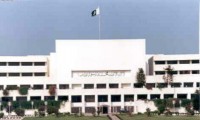 Islamabad, the capital of Pakistan, is located against the backdrop of Margalla Hills at the northern edge of Potohar Plateau. In contrast to its twin city Rawalpindi, it is lush green, spacious and peaceful. Islamabad is a city of wide, tree-lined streets, large houses, elegant public buildings and well-organized bazaars. Traffic jams and crowds are rare, and narrow lanes and slums are few and far between. Sidewalks are shaded and safe behind rows of flame trees, jacaranda and hibiscus. Roses, jasmine and bougainvillaea fill the many parks, and scenic view-points show the city to its best advantage.
Islamabad, the capital of Pakistan, is located against the backdrop of Margalla Hills at the northern edge of Potohar Plateau. In contrast to its twin city Rawalpindi, it is lush green, spacious and peaceful. Islamabad is a city of wide, tree-lined streets, large houses, elegant public buildings and well-organized bazaars. Traffic jams and crowds are rare, and narrow lanes and slums are few and far between. Sidewalks are shaded and safe behind rows of flame trees, jacaranda and hibiscus. Roses, jasmine and bougainvillaea fill the many parks, and scenic view-points show the city to its best advantage.
Excursions around Islamabad
Rose and Jasmine Garden
This 20,360 sq. meters garden is famous for its roses. It has 250 different varieties of roses as well as a dozen types of Jasmines. Flower shows are occasionally held here, particularly during spring. Nearby is a Tourist Camping Site.
Shakarparian Hills
Shakarparian hills are situated near Zero Point, at a height of 609 meters. Its terraced garden offers pleasant and sweeping vistas of Margalla and Murree hills, Rawal Lake and Rawalpindi and Islamabad.
Rawal Lake
This glistening man-made lake covers an area of 8.8 sq. km. The terraced garden and the lake are ideal for picnics fishing and boating. The highest point in the garden commands a panoramic view of the lake, Margalla and Murree hills, Rawalpindi and Islamabad
Daman-e-Koh
This low hill over looking Islamabad, known as Daman-e-Koh, offers panoramic view of Islamabad. Snack bar facilities are available at PTDC's Daman-e-Koh Restaurant. The place is ideal for afternoon and evening outings with family and friends.
Pakistan Museum of Natural History
The Museum depicts early human history, geology, and wildlife of Pakistan. The exhibits are particular interest to students and children.
Islamabad Museum
Islamabad museum presents the history of the land where Pakistan is situated today. Pakistan has been a seat of the world痴 leading civilizations from time immemorial.
Shah Faisal Mosque
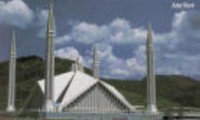 This beautiful mosque was designed by a renowned Turkish Architect, Vedat Dalokay and named after late King Faisal of Saudi Arabia. It is spread over 1,89,705 sq, meters with 88 meters high minarets and 40 meters high main prayer hall. The main prayer hall can accommodate 10,000 persons, while the covered porticoes and verandahs can take over 24,000 worshipers. The main courtyard has space for 40,000 people.
This beautiful mosque was designed by a renowned Turkish Architect, Vedat Dalokay and named after late King Faisal of Saudi Arabia. It is spread over 1,89,705 sq, meters with 88 meters high minarets and 40 meters high main prayer hall. The main prayer hall can accommodate 10,000 persons, while the covered porticoes and verandahs can take over 24,000 worshipers. The main courtyard has space for 40,000 people.
Mountaineering in Pakistan
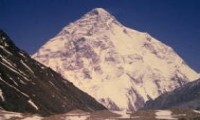
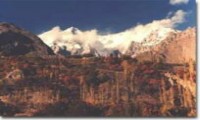
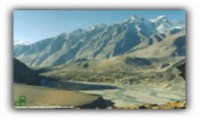
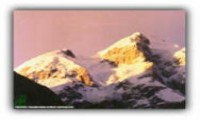
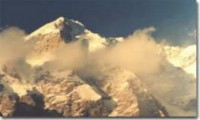
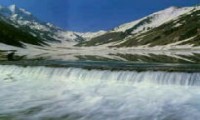
Northern Pakistan has the greatest concentration of the highest peaks in the world. It has 05 peaks over 8,000 metres including the world痴 second highest, K-2 (Chogori, 8611 m), 29 peaks of over 7,500 metres and 121 of over 7,000 metres. Hundreds of peaks have yet to be climbed. This, is a great challenge for the mountaineers and mountain climbers the world over. All peaks/routes for mountaineering have been designated as open zone or restricted zone.
| S.No | Peak | Height (m) |
International. Ranking |
Range |
| 1 | K-2 | 8611 | 2 | Karakoram |
| 2 | Nanga Parbat | 8125 | 9 | Karakoram |
| 3 | Gasherbrun I | 8068 | 11 | Karakoram |
| 4 | Broad Peak | 8047 | 12 | Karakoram |
| 5 | Gasherbrum II | 8035 | 14 | Karakoram |
| 6 | Gasherbrum III | 7952 | 15 | Karakoram |
| 7 | Gasherbrum IV | 7885 | 20 | Karakoram |
| 8 | Distaghil Sar | 7885 | 20 | Karakoram |
| 9 | Kunyang Chhish | 7852 | 22 | Karakoram |
| 10 | Masherbrum NE | 7821 | 24 | Karakoram |
| 11 | Rakaposhi | 7788 | 27 | Karakoram |
| 12 | Batura | 7785 | 25 | Karakoram |
| 13 | Kanjut Sar | 7760 | 29 | Karakoram |
| 14 | Saltro Kagri | 7760 | 29 | Karakoram |
| 15 | Trivor | 7720 | 6 | Karakoram |
| 16 | Tirichmir | 7708 | 41 | Karakoram |
| 17 | Chogolisa | 7654 | 46 | Karakoram |
| 18 | Shispare | 7619 | 49 | Karakoram |
| 19 | Skyang Kangri | 7544 | 58 | Karakoram |
| 20 | Pamuri Chhish | 7492 | 67 | Karakoram |
| 21 | Noshaq | 7492 | 68 | Karakoram |
| 22 | Tirichmir NW | 7487 | 69 | Karakoram |
| 23 | K-12 | 7468 | 73 | Karakoram |
| 24 | Teram Kangri | 7468 | 73 | Karakoram |
| 25 | Malubiting W | 7452 | 76 | Karakoram |
| 26 | Sia Kingri | 7422 | 79 | Karakoram |
| 27 | Skilbrum | 7420 | 80 | Karakoram |
| 28 | Teram Kangri II | 7406 | 84 | Karakoram |
| 29 | Haramosh | 7406 | 84 | Karakoram |
| 30 | Istro-o-nal | 7403 | 85 | Karakoram |
| 31 | Mt Ghent 7400 | 7400 | 86 | Karakoram |
| 32 | Yukshin Gardan | 7400 | 87 | Karakoram |
| 33 | Ultar Sar I & II | 7388 | 88 | Karakoram |
Trekking in Pakistan
Pakistan is a paradise for trekkers. Most of the trekking routes lies in the northern mountains of the Hindukush, the Karakorams and the Himalayas. For most of the treks, trekking season is between May to October. The Ministry of Tourism, Government of Pakistan, has defined trekking as walking below 6000 m. It has designated three zones for trekking; open, restricted and closed. Foreigners may trek anywhere in open zone without a permit or services of a licensed mountain guide.
What to buy
Pakistan is a treasure house of exquisite handicrafts, made by people who grew up weaving, creating pottery, working with metals wood and stone,decorating and building things small and great. Pottery here is a living history, a traditional craft that became an art, with its origins going back to 3,000 years B.C. Today, each region of Pakistan claims its own special jars and jugs, from sturdy terracotta to paper-thin ceramics. In vivid colours of mustard yellow, deep green, brick red and sky blue. For those keen on shopping, the prices are still quite reasonable. You will find yourself returning home with hand-woven carpets, copper and brass items, woodwork, embroidered urtas・(shirts) and hussas・shoes) and countless objects dirt.
Events and Festivals
|
Eid-e-Milad-un-Nabi
Birth Annniversary of Prophet Hazrat Mohammad (P.B.U.H), on 12th of Rabi-ul-Awwal - the 3rd month of Islamic Calendar. |
|
Joshi or Chilimjust: (14-15 May)
Kalash festival of welcomming spring, held in Kalash Valleys near Chitral. Folk dances, music andexchange of dishes. |
|
Shandur Polo Festival (7-9 July)
A regular traditional polo tournament is held every year on the highest polo ground of the world. The Shandur Pass (Chitral district), with allied activites including folk music, folk dances and other competitions |
|
Utchal: (15-16 July)
A harvest Festival,Celebrated by Kalash people in Kalash Valleys, Chitral. |
|
Jubilee Celebrations of High Mountains: From July 10 -14
Jubilee Celebrations of High Mountains: Golden Anniversary of K-2 and 51st Anniversary of Nanga Parbat |
|
Independence Day (August 14) *
Celebration of Independence from British Rule |
|
Death Anniversary of Quaid-i-Azam (September 11) *
Death Anniversary of the Founder of Islamic Republic of Pakistan Quaid-i-Azam Muhammad Ali Jinnah |
| Month "Shawal" celebrated after the Holy Month of "Ramadan" |
|
Birth Day of Quaid-e-Azam *
A national day for Pakistanis due to Birth Day of Quaid-e-Azam Muhammad Ali Jinnah |
Tourist Information Centers
| City | Address |
| ABBOTTABAD | Club Annexe, Jinnah Road.Tel: 0992-334399 |
| BAHAWALPUR | PTDC Motel, Club Road, Near DC Office.Tel: 0621-82835 Fax: 0621-85362 |
| GILGIT | PTDC Motel Chinaar Inn, .Tel: 0572-4262 |
| ISLAMABAD | Agha Khan Road, Markaz F-6 (Super Market).Tel: 051-9202766, 9212760 Fax: 051-920402 |
| ISLAMABAD AIRPORT | Opposite International Arrival Lounge, Islamabad International Airport. Tel: 051-9280563 |
| KARACHI | Shafi Chambers, Club Road, Saddar. Tel: 021-9202971 Fax: 021-9206376 |
| KARACHI AIRPORT | International Arrival Lounge, Quaid-e-Azam International Airport. |
| LAHORE | Room No.3, Faletti's Hotel, Egerton Road. Tel: 042-6363946 Ext.TIC, 6306528 Fax: 042-6364819 |
| LAHORE AIRPORT | Opposite International Arrival Lounge, Lahore International Airport. Tel: 042-92200231 |
| MOENJODARO | PTDC Motel. Tel: 0741-459266 Fax: 07443-493 |
| MULTAN | Hotel Sindbad, Nishtar Chowk, Bahawalpur Road. Tel: 061-512640 |
| PESHAWAR | Benevolent Fund Building, Saddar Road.Tel & Fax: 091-286829 |
| QUETTA | Muslim Hotel, Jinnah Road. Tel: (081) 825826 |
| RAWALPINDI | Room No.7, Flashman's Hotel, The Mall.Tel: 051-514672, 581480 Ext.7 |
| SAIDU SHARIF | PTDC Motel, Opposite Serena Hotel.Tel: 0936-711205 Fax: 0936-713776 |
| SKARDU | K-2 Motel. Tel: 0575-2946 Fax: 0575-3322 |
| SOST | (1st May to 15th November)PTDC Motel, Pak-China Border. |
| TAFTAN | PTDC Motel/Reception Unit, Pak-Iran Border. Tel: 0886-510302, 510248 |
| THATTA | PTDC Hospitality Complex. |
| TAXILA | PTDC Motel, Opposite Taxila Museum, Museum Road. Tel: 0596-2344, 534890 |
| WAGHA | PTDC Motel/Reception Unit, Indo-Pak Border. 042- |

